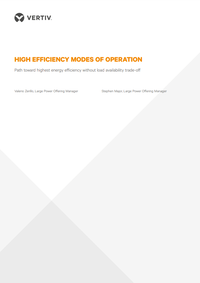One of the most widely discussed issues throughout the world today is the rapidly increasing price and demand of energy supply. Along with this comes the broadening awareness of the environmental impact and depletion of fossil fuels, which has created a natural drive towards energy saving and the widely encouraged use of renewable energy sources, energy conservation best practices, and the development and advancement of energy efficient standards, processes and technologies. As maximum uptime is paramount for many world-leading organizations, the presence of a UPS is an indispensable prerequisite for a reliable power infrastructure able to achieve maximum load safeguarding and conservation.
The most common UPS topology currently used in the industry is double conversion; nevertheless, most UPS suppliers have introduced ECO Modes of operation to further increase the levels of efficiency of the UPS.
In this paper, we will analyze the drawbacks of ECO Mode types of operation and further highlight what elements should be considered when using these modes of operation. We will then review the field results achieved by the Liebert® Trinergy™ Cube UPS and present the recent improvements in technology that have been incorporated into the Liebert Trinergy Cube and Liebert EXL S1. Vertiv™ UPS have introduced new ways of efficiency improvement to the market which have proven to be the premium UPS solution for data centers aiming to have the lowest possible PUE while maintaining the highest levels of availability.

